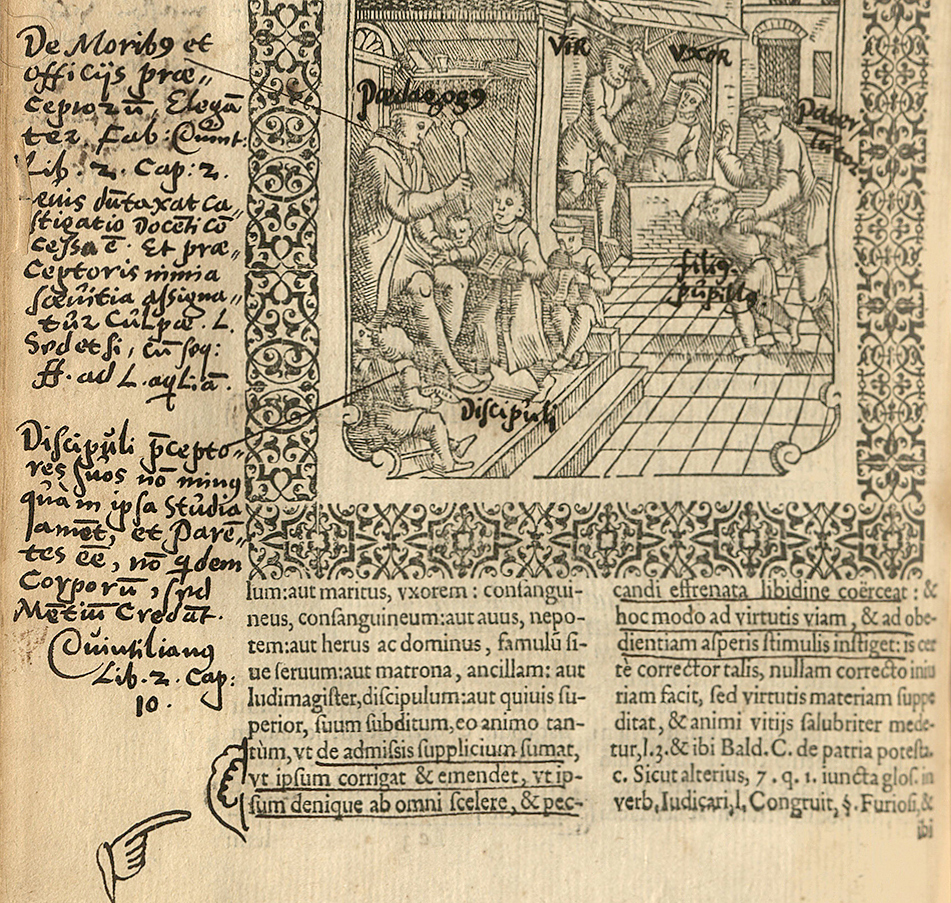Law Students and Their Books
Taking notes on oral lectures and annotating legal texts, quickly or more carefully, are time-honored student traditions that reveal a wealth of information about legal education. Student notes in particular often help us to reconstruct the content of lectures and the progression of courses whose content would otherwise be lost. These valuable materials shed light on how students in the past organized legal information, interacted with texts, and absorbed new doctrines, all of which are integral to the history of legal education.
Joost de Damhoudere, Praxis Rerum Criminalium … (Antwerp, 1570).
First published in 1554, the Praxis was the most comprehensive work on criminal law and procedure in its contemporary northern Europe, and perhaps the most vividly illustrated law book of all time. It was a best-seller that appealed to students and practitioners for more than a century. This copy is richly annotated, likely by a contemporary German law student. Adding notes in German, with Latin and Greek quotations, the student was as interested in literature as in law. The illustration here, labelled and annotated, shows a range of permissible corporal punishments, including the physical correction of students by teachers.
The copy comes from the library of Hermann Kantorowicz (1877-1940), one of the great legal scholars of the 20th century and an authority on criminal law. The Riesenfeld Center holds Kantorowicz's personal library in its collections.
Anthony Fitzherbert, La Novvelle Natura Breuium [La Novelle Natura Brevium] (London, 1581).
Fitzherbert (1470-1538) was an English barrister and judge who wrote several of the most important legal works of the sixteenth century. His La Graunde Abridgement (1515-17), a collection of more than 13,000 cases, has been called the book that “made” the common law. His Novelle Natura Brevium, first published in 1534, is a collection of writs with discussion of legal developments. This copy is particularly notable for its annotations. Since studying writs was a foundation of English legal education, it is not unlikely that these were student notes. The wide-margined pages were created for notes: here there are extensive citations to statutes and cases, making it a personalized reference work. The copy was later trimmed or retrimmed for a binding, after the annotated pages were folded in.
[Richard Preston]. Manuscript on Abstracts of Title (London, 1807).
This appealing manuscript records lectures given by Richard Preston (1768-1850) at King’s College, London, in 1807, which formed the basis of his published Essay in a Course of Lectures on Abstracts of Title (1817-1818). The property law topic included much of what is familiar to students today, and the notes were taken by a student, Francis Twemlow. The notes are a fair copy for continued use and perhaps circulation. Fine manuscripts and letters of the period are often found on hand-made laid paper like that here, which bears the watermark “W. Turner 1802” (William Turner and his sons were active at Chafford Mills in Kent). Student notes are often valuable records of otherwise unpublished lectures.



